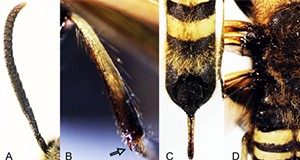
The tea shot-hole borer is an Asian ambrosia beetle introduced to Florida in the early 2000s. In Florida it does not have any known economic impact, but it is a serious pest of tea around the world and is one of the few ambrosia beetles that can infest healthy plants. The tea shot hole borer has a symbiotic relationships with the ambrosia fungus Fusarium ambrosium (Gadd & Loos), which is also a weak plant pathogen. This 4-page fact sheet includes diagnosis section with guidance for avoiding misidentification. Written by You Li, Andrea Lucky, and Jiri Hulcr, and published by the UF Department of Entomology and Nematology, June 2015.
http://edis.ifas.ufl.edu/in1090
Tag: You Li
Asian Horntail Eriotremex formosanus (Matsumura) (Insecta: Hymenoptera: Symphyta: Siricidae: Tremicinae)

Since it was introduced to North America, the Asian woodwasp has become the most common wood wasp in Florida. It is not considered an economically important pest because it only attacks dying or dead trees, but the species may someday prove to be a pest and its ecological impacts in North American forests remain unknown. This 4-page fact sheet was written by You Li and Jiri Hulcr, and published by the UF Department of Entomology and Nematology, June 2015. (Photo credit: You Li, UF/IFAS)
http://edis.ifas.ufl.edu/in1095